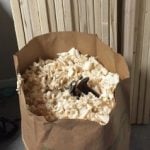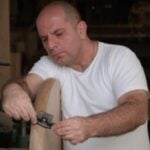Trouble with a mortise
Welcome! / Forums / General Woodworking Discussions / Woodworking Methods and Techniques / Trouble with a mortise
- This topic has 23 replies, 2 voices, and was last updated 1 year, 10 months ago by
 Jan Khmelnytsky.
Jan Khmelnytsky.
-
AuthorPosts
-
16 July 2017 at 10:42 pm #313758
Hi there,
I’ve been working on my first ever mortise and tennon. I’ve watched lots of Paul’s videos and it looks as if the chisel glides into the wood like butter. I am working with some sort of pine that’s quite old. I’ve sharpened my chisels on oil stones and stropped – to a point where I feel it’s pretty sharp.
When I start my mortise, I use Pauls technique he teaches in his videos, but I am unable to advance anywhere near as quick through the wood. I can’t understand why it’s feeling so difficult given it’s pine of some type. Could this be down to my chisel actually not being sharp enough or just bad technique?
-
This topic was modified 6 years, 9 months ago by
Mathew Doidge.

1) Paul makes everything look easy. There’s even a video (I forget which one) where he says, “I’m making this look easy, but it’s not” and he was correct.
2) As a beginner, I’m always refining my opinion of what constitutes “sharp”. It’s a lot sharper than it used to be.
3) Pine might be a softwood, but it’s not wet tissue paper. Keep in mind that aspects of wood such as hardness and strength and workability are not the same thing. I’ve had pieces of poplar (considered the softest hardwood) that were like bricks, and I’ve had pieces of poplar that cut easier than much pine I’ve worked. There can be quite a bit of variation among even the same species of wood.
4) As a beginner, many aspects of woodworking will be difficult and slow and tedious and error prone and challenging. That’s what we have to deal with as beginners. In a year, you’ll have improved so much you’ll chuckle at what you used to find difficult. As Paul says, persevere.
Having said all that, it certainly could be dull tools, sub-optimal technique, a combination of the two, and perhaps even other factors. If you feel things can reasonably be said to be ridiculous, post a video of yourself chopping a mortise, maybe one of the more experienced members will see something that can be improved.
17 July 2017 at 10:27 am #313769When I built my workbench I really struggled with the mortises, they were taking me somewhere between 40 minutes to an hour to cut each one. I lost patience at one point and ruined a leg, that was a hard lesson to learn.
Paul Sellers has cut thousands of these, I’ve cut maybe 20 max, you’ve cut one. Give it time and enjoy the process 🙂
Rob
17 July 2017 at 11:46 am #313770I am certainly not put off in any way, and I’m starting my second right away. Time to improve! I might try some new stones for sharpening as my current inherited oil stones don’t seem overly effective. Thank you all for replies – I may well record my next mortise and get some tips as you suggest @etmo
18 July 2017 at 9:37 pm #313832As others already said, pine is quite difficult to cut precisely, because it is so soft, while having quite strong annual rings eventually. Besides, I think, Paul Sellers’ chisels are really really sharp and he is doing mortise holes for over 50 years now.
My first mortise holes were a mess, not only, because I didn’t follow the instructions in the videos, and it tool awfully long to cut them. A bit later, I watched one video again and even took notes. Then I was quite at ease, but didn’t pay too much attention to perfection, I only tried to replicate the method to the point. From there on, it went better quickly. I still get massive tearout in pine or fir, especially, when I am too lazy to sharpen my chisel, but I am in control of the general process now.
Dieter
 19 July 2017 at 9:04 am #313853
19 July 2017 at 9:04 am #313853There isn’t a woodworker out there who hasn’t been where you are now. Like you I’m fairly new to this too and suffer the same issues. It’s easy to let doubt creep in and morph into frustration. But I know for me at least, most of it is down to lack of technique, be it in sharpening getting that razor edge or actually doing the woodworking.
My first tenon joints which were for my bench were not pretty and they took what seemed an age to me to do, but I was still as proud as punch when the whole project came together. Now it may not be a piece of woodworking art but it’s functional, sturdy and more importantly ‘I made it’. Being my bench, it will always be there to remind me of my beginnings and a marker of how far I’ve come.
The saying ‘Practice Makes Perfect’ may seem trite, but remember Paul has had 50 years of practice; we’ve had 5 minutes in comparison. You’ll look back in time and see a similar thread to this one and give a wry smile.
As for pine and tear out, I found with me it was the lack of sharpness of my chisels. In the end I bit the bullet, and over a period of time saved for the diamond plates and they, along with my improved technique, have made a huge difference.
Try clamping the work to your bench top rather than working in the vise and see if that makes a difference. If possible, clamp over a leg.
Sharpen your chisel, take a few chops in the mortise, and then feel the chisel edge for a bur. You may find one has magically appeared after the mallet blows. If so, you’re not getting the bur off fully when sharpening. If no bur, go back to work but check a few more times. If you’re working in pine, drive a few blows into oak, again to see if a bur appears.
It’s normal to be slower than Paul, but you should be getting chips that look like his. If you are getting chewed up wood, then you need to figure out what to change (technique or sharpening), but if your chips looks somewhat like his, keep going, you’re on the right track.

Hi Mathew,
The advice given by the other members is spot on. As Ed pointed out clamp the piece to your workbench instead of in your vise. When I made my first mortises I used a workmate and it took me a while to figure out that the workmate deflects a lot of the energy from the hammer blows. The workmate was shaking and produced a lot of noise, but the chisel didn’t cut deeply into the wood at all.
When I figured that out I put the piece on the floor and finished the mortises that way.
Wesley
19 July 2017 at 3:00 pm #313862Great advice, thank you. I must admit I had noticed the vice on the workmate was rubbish and as you mentioned, it was taking a lot of the force out from my chisel blows. I quickly discovered working on top of some MDF on the floor was much better.
I’m just attempting to square a new piece of timber so I can try again. I will take on board the great advice
You’ve got it- I was worried you were using a bouncy vise that was absorbing all your effort, but if you are directly on the floor, that rules that out. You must have a strong back to whack mortises bent over on your knees!
Another possibility is that your grip is choked all the way up on the hammer, right next to the head, so that you don’t get much force. Carpenters hold the hammer down at the end of the handle to maximize the force of each blow, but woodworkers and carvers tend to find a sweet spot near the head, but still just a bit back. Paul once told us it was like you are flicking the head of the hammer. I think I’m somewhere between that and the carpenter grip. Anyway, play with that too. I’ve seen some people make a great show with a hammer yet have almost no force because they just weren’t holding it right.
Again, I think the most telling thing is what your chips look like.

Ugh–cutting mortises in pine 2x4s has always been a challenge for me. Yes, it is softer wood but I think that actually makes it more difficult to chop cleanly. When I built my bench I noted that my mortises looked like “layer cake” because the annual rings seemed to separate no matter how hard I tried to cut them cleanly and methodically.
 19 July 2017 at 8:41 pm #313878
19 July 2017 at 8:41 pm #313878Looks good to me David, mine was a mess!
I will post some pictures when I get some time to start my next. Will have to wait for me to flatten and square it, so could take me a while !!
 20 July 2017 at 1:18 am #313881
20 July 2017 at 1:18 am #313881It’s always a challenge to chisel a wood that has harder and softer core. The first cut will be clean, one it meets the hard growth ring, and cuts through, it will smash the softer layer below it.
For my bench I used spruce, which in Los Angeles/Burbank happened to be found only at Lowes store. Spruce feels a bit “dense” and cuts are much appealing…
Anyhow, if you’re really shooting for “smoothest” cut mortise, perhaps with your woodstock I think drilling out the mass would make it cleaner.
Good luck

Somewhere you mentioned “inherited” oilstones. Check the stones are flat across. If not, that prevents the chisel from getting sharp in the middle. I had that problem with one of my waterstones. After flattening the stone, my plane iron was transformed to a thing of wonder.
-
This topic was modified 6 years, 9 months ago by
-
AuthorPosts
- You must be logged in to reply to this topic.
